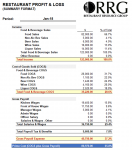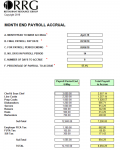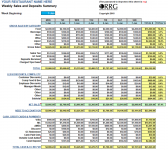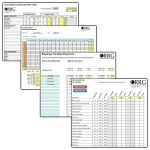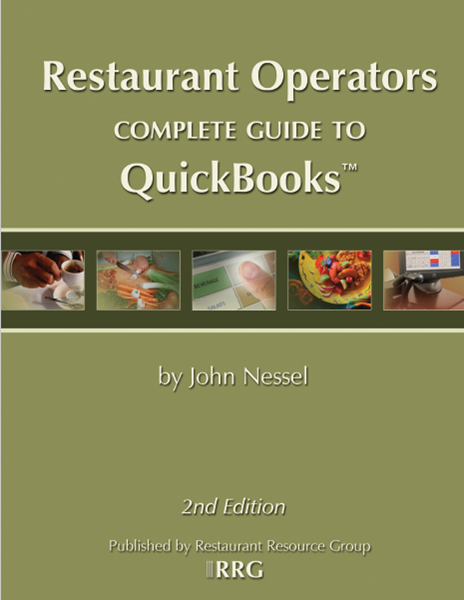
Restaurant QuickBooks Guide, 2nd Edition (PDF Format)
Restaurant Accounting is
made easy with this publication.... A 298 page step-by-step guide to the most
popular small business accounting software program. Written exclusively for
restaurant operators, in a jargon free and easy to understand style. The author,
John Nessel, a thirty-six year veteran of the restaurant industry, and
currently a restaurant consultant, is a Certified QuickBooks Advisor, and has
been using QuickBooks since 1994.
Only $79
The Importance of Monthly Restaurant Financial Reporting
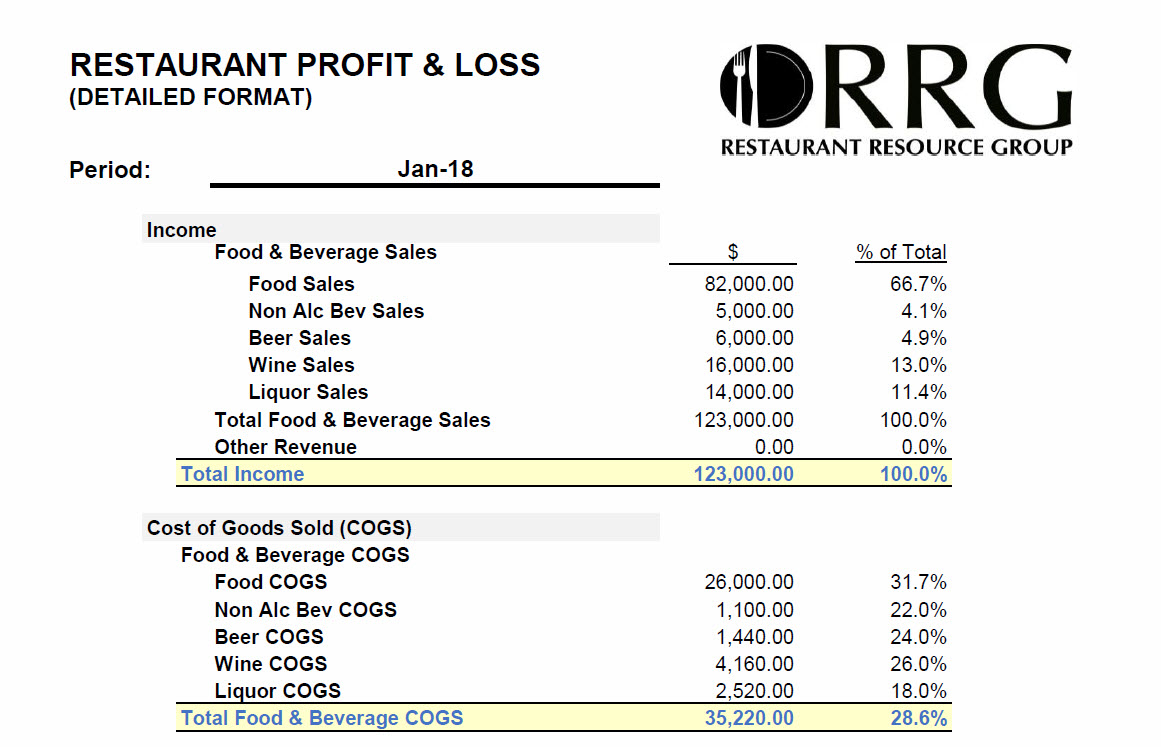
The three critical financial statements that every restaurateur must prepare each month is:
1. the Profit and Loss Statement (P&L)
2. the Balance Sheet; and
3. the Statement of Cash Flows.
The most important of these is the P&L. No business can be run without numbers. Numbers
serve as a thermometer that measures the health and well-being of the
enterprise. Numbers are symbols, very much like words, with their own intrinsic
simple meanings when they stand alone and far more complex and meaningful when
in the context of pertinent other numbers.
There is nothing unique or unusual about the
importance of knowing your numbers. However, the difference between
well-managed companies and not-so-well-managed ones is the degree of attention
they pay to their numbers.
If you do not produce regular monthly financial
reports on your restaurant, you are flying blind. One critical mistake often
made by new restaurant entrepreneurs is that they think they can save a few
dollars by doing their own accounting and get by without the expense of a
professional accounting service.
However, like the saying, The individual who
chooses to act as his or her own lawyer in a court case has a fool for a
client, so is the restaurateur who believes he does not need the services of a
professional hospitality accountant to set up his business books. My personal
experience in working with independent restaurant operators who choose to do
their accounting in-house is that their accounting records and reports are
marginally acceptable to the IRS for income tax purposes and woefully
inadequate as financial management tools for evaluating the financial condition
of their restaurant.
In one case, I worked with a financial
institution when one of their loan customers stopped paying their business
loan. I was asked to look into their situation to see if foreclosure could be
avoided. The couple that built and operated this restaurant had collateralized
their loan with their life savings and retirement funds. The first thing I
asked to see was the financial statements for the last 12 months. When I
reviewed them, I was unable to assess the financial condition of the restaurant
because the statements were prepared using cash accounting instead of accrual
accounting. The local public accountant they used was not familiar with
hospitality accounting and the Uniform System of Accounts for Restaurants.
When I asked the accountant why he was not using
accrual accounting, he replied that there were tax advantages in using cash
accounting. Of course, that was a moot point since the business had never made
a profit. But the biggest travesty of using the cash system was that it had
hidden the fact that their costs were way out of line. In fact, a break-even
analysis showed they were never going to be profitable.
The primary purpose of monthly financial
statements is not to serve as an IRS form to determine your tax liability. The
purpose is to be able to assess the effectiveness of the owner's decisions on
the financial performance of their business. Every decision a restaurateur
makes has financial implications. Adding or deleting a menu item, adding or
eliminating an employee position, changing a menu price, giving an employee a
raise, selecting a new vendor for your supplies, changing the portion size of
an entre and changing your hours of operation all have financial implications.
Your goals should be to increase sales, reduce
costs and increase profit. These are the objectives for any decision you make
for your business. The bottom line is that if you do not know your numbers, you
do not know your business.
The first and most important point about numbers
is that they must be accurate and collected in a timely manner. I was asked by
a successful independent restaurant operator to assess his business and
determine its value. I agreed to do so without any charge and asked him to
provide me with the past 12 months of income statements and balance sheets.
I began to suspect something was awry when he
asked me to guess what his food cost was running and told me to guess. My
response was 27 percent? He said it was 17 percent. No restaurant should run that
low of a food cost because in order to do it, prices would be outrageous, the
portions miniscule and the quality dubious. That was not the case with this
restaurant.
When I looked over his accounting records, which
he did himself with QuickBooks; I saw several glaring flaws in his accounting.
Again, he was using cash accounting instead of accrual accounting, and he did
not separate his beverage sales from his food sales in calculating his food and
beverage cost percentages. When I examined the current assets section of his
balance sheet and did not find an entry for food or beverage inventory, this
told me he was not taking inventory each month and that the numbers he used for
food and beverage cost on his income statement were likely the purchases
(invoice totals) for the month. The reason he came up with a food cost of 17
percent was because he was dividing food purchases by total sales when it
should have been only food sales. In addition, the sales figure he used was
gross sales, which included sales tax.
It seems that there are operators who are
numbers people who enjoy analyzing financials, and then there are those who are
not and are uncomfortable with numbers. Those who are not often defer
collecting and recording numbers to someone else, and do not really understand
what the numbers are telling them. They may not even keep track of customer
counts, sales or the preparing of reports. The latter are numbers that every
restaurant manager, let alone owner, should check every single day.
Another very successful operator asked my advice
because his business had almost been bankrupted by a trusted employee, and he
did not want that to happen again. Again, this operator chose to keep his
accounting in-house and not to use a professional hospitality accounting
service. In addition, he was not comfortable with numbers and deferred to
others who never took a month-end physical inventory and were using monthly
purchases as food cost on the monthly statements. (A physical inventory means
that you will count all food, beverages (alcoholic) and supplies on hand at the
end of the month and extend the value of that inventory.)
The amount that is used for food cost on your
income statement must be cost of food sold, which must be calculated using the
formula Beginning Inventory plus Purchases minus Ending Inventory. That
calculation produces cost of food consumed, and the Uniform System of Accounts
uses cost of food sold, which is cost of food consumed less employee meals,
discounts and complimentary meals, food transfer to the bar and recorded waste.
My first recommendation was to take a monthly
inventory and extend it. Despite my recommendations to get that information,
his operations manager slow-played the process and after three months I
withdrew without ever getting an inventory value. The owner was not a numbers
person and had delegated this important task to his operations manager. I knew
that this was not a good situation and one that should not be permitted. It
preyed on my mind so much that several months later I asked him if he ever got
the inventory completed. They had not. I then told him that as long as he did not
have a month-end inventory, he was vulnerable to the same fraud that had nearly
bankrupted the company earlier.
The detail needed by an operator on their
financial statements is far more detailed that that needed by the IRS to
determine tax liability. I recommend that, at least initially, new restaurants
should retain the services of a professional hospitality accounting firm or consultant to set
up their QuickBooks file and procedures. The cost of this service is about 1 percent of
your sales, and that is the best money you will ever spend.
The restaurant accounting professional will show you how to record
your daily sales and deposits, payments for supplies and payroll, and they can prepare your sales tax and
payroll tax forms each quarter. Your in-house bookkeeper can assemble the data
for your accountant and use QuickBooks to do that if you wish. If, after a
year you believe that cost for such services and peace of mind is too much and
you are a numbers person, you can consider doing everything in-house because
you will have a template for what you need to do. One caveat is that in-house
accounting is NOT the way to go if you are NOT a numbers person and the
recommendation to do away with the outside accountant is adamantly supported by
your in-house bookkeeper. You need to have a system of checks-and-balances when
it comes to your financial records.
When you have mastered the numbers, you will no
longer be reading them any more than you read words when reading a book. You
will be reading meanings. Your eyes may be seeing numbers, but your mind will
be reading food cost, market share, gross profits, prime costs, etc. All the
things you are doing and planning will jump out at you, if you will only learn
to read through the numbers.
Dr. David Pavesic is a
former restaurateur and retired professor at the Cecil B. Day School of Hospitality
at Georgia State University.

